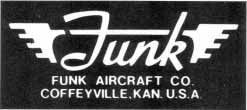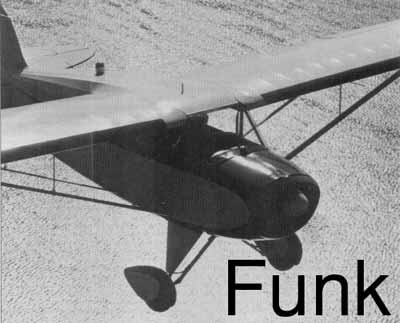There is a fine line between ridiculing an aircraft and enjoying
its more whimsical aspects, which is what makes it so difficult to
talk about the Funk aircraft series. It's also necessary to recognize
that the definition of "whimsical" changes over the years
and what was serious or hardly worth discussing 50 years ago is now
something that forms the center of snide comments and quick-witted
remarks and that's the position in which the Funk now finds itself.
Over a half century after it was introduced as a sparkling new two-place
airplane with some interesting innovations, the Funk is
now on the wrong end of jokes.
I tend to seek the lighter side of life more often than not, which
makes it not only easy for me to see the fun in something, but I am
also able to gravitate toward people, events and airplanes that lean
in that same direction. For that reason alone, I am probably
more attracted to the Funk than many. And one of the Funk's primary
attractions for me is the plane's out and out whimsical nature.
In my definition of "whimsical" the Funk is possessed of
a combination of characteristics one normally associates with the happy
sidekick of the western hero. The Funk is the Gabby Hayes of the classic
light plane set. Other light planes are considered to be more practical
and, by some definitions, more desirable than the Funk, but none are
more fun or possess more out and out character. In point of fact, the
rest are almost too ordinary while the Funk is a totally unique character.
All the foregoing was said with one primary goal: To let Funk owners
know this is a smile of enjoyment on my face, not a smirk of ridicule.
Like Jets fans, Funk owners probably take their fair share of grief
ranging from the airplane's name to its low slung stance and I don't
want to be credited as one who takes unnecessary cheap shots — although
I have, and will, take my share.
In doing research on the airplane after flying the craft, an awful
lot of what I thought and know about the Funk changed — including
the fact that it's difficult to make fun of an airplane's name knowing
the name still belongs to two distinguished and very much alive gentlemen
in Coffeeville, Kansas. The Funk brothers (no comment), Howard and
Joe, who also happen to be twins are the aircraft's designers and builders.
They are still very much an active part of the aviation scene at 80
years of age.
For as long as I've been messing with airplanes I've been meaning
to track down a Funk owner and beg for a ride just to see if they flew
the way they looked or if they flew the way they didn't look. For one
reason or another I never completed the mission until Oshkosh of this
year. At that point I was wandering up and down the rows of classics
in a semi-comatose state when I walked past this pretty red and white
job and thought "it's now or never" and so out came the ever-present
notebook and I wrote a quick note to the owner asking him if he would
be willing to meet us at Fond du Lac a few miles south to take some
pictures and do a little flying. It was quite literally an "occupant" type
of letter since I didn't know the owner or his plans. So it was with
a fair amount of glee that I ran down to Fond du Lac later in the day
and found Dan Stoor and his red and white Funk parked on the ramp at
Fond du Lac waiting for us.
Cheap shot number one: If I owned one of these things and kept it for
a long time I would paint it blue so folks would be able to say, "he's
always in a blue funk;' or "he left in a blue funk:' If that goes
over your head, go hang out with some of your jazz musician friends.
Dan, now a DC-10 pilot, has owned NC1613N since 1978 during
his college days at Purdue where he did the majority of the restoration
on the airplane, including recovering. His airplane is serial number
413, which makes it one of the last ones made in 1947 before the line
shut down less than a year later.
The Funk line is interesting because the two brothers were not professional
aircraft designers and didn't have the background one would expect
for getting into the airplane business. Their primary asset was a strong
desire to design and build a good little two-place airplane. They originally
started working on the idea about 1934 with a friend, Pratt Jones.
They finished the airplane in time to take it to the national air races
in 1937 where the design received a lot of attention. Much of the attention
was directed at their powerplant: They had bypassed the normal aircraft
engines and mounted a four-cylinder Ford Model B engine which they
had converted to airplane use.
The Model B Ford, for those of you who don't know, was the third in
a series of four high-production four-cylinder engines designed by
Ford, the first being the famous Model T and the second being the equally
famous Model A. The Model B engine is not as well known because it
came out in 1932 — the same time the wildly popular flathead
V-8 was introduced by Ford. The four-cylinder B engine was an upgrade
of the earlier A engine in that it had a pressurized oil system rather
than relying on splash lubrication. The Funk brothers took the engine,
turned it upside down — obviously modifying the sump to allow
it to work in the inverted situation — and hung a prop on the
front. This configuration supposedly turned out 63 hp at
2125 rpm and could pump out as much as 70 hp at 2450 rpm for takeoff.
The drawbacks to the engine were obvious: It was heavy and required
a cooling system. By the same token, in 1934 there was no such thing
as a commonly available low horsepower four-cylinder aircooled engine
of similar horsepower. The 37 horse Aeronca engine was around as was
the 40 horse A-40 Continental. Howard and Joe did the same thing many
designers are still trying to do today: Take advantage of the mass
production capabilities of the automotive industry and,
through minor modifications, adopt those cheaper mass produced
engines to aircraft use. In actuality, this method worked better for
the Funk brothers than for anyone since.
The airplane attracted so much attention that eventually a group of
businessmen from Akron, Ohio, agreed to finance the formation
of a company called the Akron Aircraft Company which built between
50 and 100 Model B Funks using the converted Ford engine.
Incidentally, the factory designation for the converted engine was
Funk "E" and I'm passing up some great lines here.
By 1940, the company was experiencing minor problems with the B engine
and there were alternatives by then available in the form of various
Lycoming and Continental engines. They opted to use the geared 75 horse
Lycoming and introduced a new 1940 model called the Funk B75-L. They
were producing both the original Model B and the B-75 until
they ceased production because of the war in 1942. Approximately 60
B-75-Ls were produced before closing the door.
A little-known chapter in the Warbug category is that at least one
Funk soldiered through all of World War Two as a UC-92 with the 6th
Air Force in Panama.
In 1941, the brothers grew dissatisfied with the overall operating
situation in Akron and moved back to Coffeyville, Kansas, where they
were both born and raised and where they still reside today. When the
war ground to a halt in 1945, the brothers resumed production
of the Funk but replaced both models with the B-85-C using an 85 horse
Continental C-85-12F with a greatly modified cowl. There are so few
of the original Ford powered Model Bs surviving that one loses sight
of the fact that the model had one of the finest cowlings ever installed
on an airplane — reminiscent of the Rearwin Speedsters and other
inline beauties whose noses had a distinct race car look. When the
brothers hung the 85 horse Continental on the front, however, they
went for maximum cooling and wound up with the guppy-like
air opening we associate with Funks.
Approximately 200 Funks were built from 1946-1948, bringing
the total figure to around 365. Of that number, around 150 are still
on the registry and an estimated 50-100 are believed to be airworthy — Dan
Stoor's airplane being one.
As I walked around Dan's airplane, it was hard to escape the feeling
the airplane was extremely low slung. This is partly due to the fact
the top and bottom lines of the fuselage are very nearly
symmetrical which puts the thrust line almost in the middle of the
fuselage. Most of the Funk's peer group has the thrust line lower in
the fuselage so the pilot sits higher above the thrust line, thus improving
visibility. This desire to put the pilot up high to see something is
what has shaped almost all two-place fuselages with the exception of
the Funk. The Funk was designed primarily around aerodynamics,
the result of which is the pilot and the squat little windshield suffer.
Also because of the squat fuselage line, the wing is much closer to
the ground than we are used to — being barely six feet at its
highest point.
Some of the Funk's peer group, notably the Aeronca Chief and the Taylorcraft
BC series, sit equally close to the ground which sometimes causes entry
problems because of strut placement. The Funk brothers were sensitive
to this and arranged their struts parallel to one another, rather than
converging to a single attach point. This makes getting into the airplane
by far the easiest of any small two-placer.
GO
TO NEXT PAGE
|



